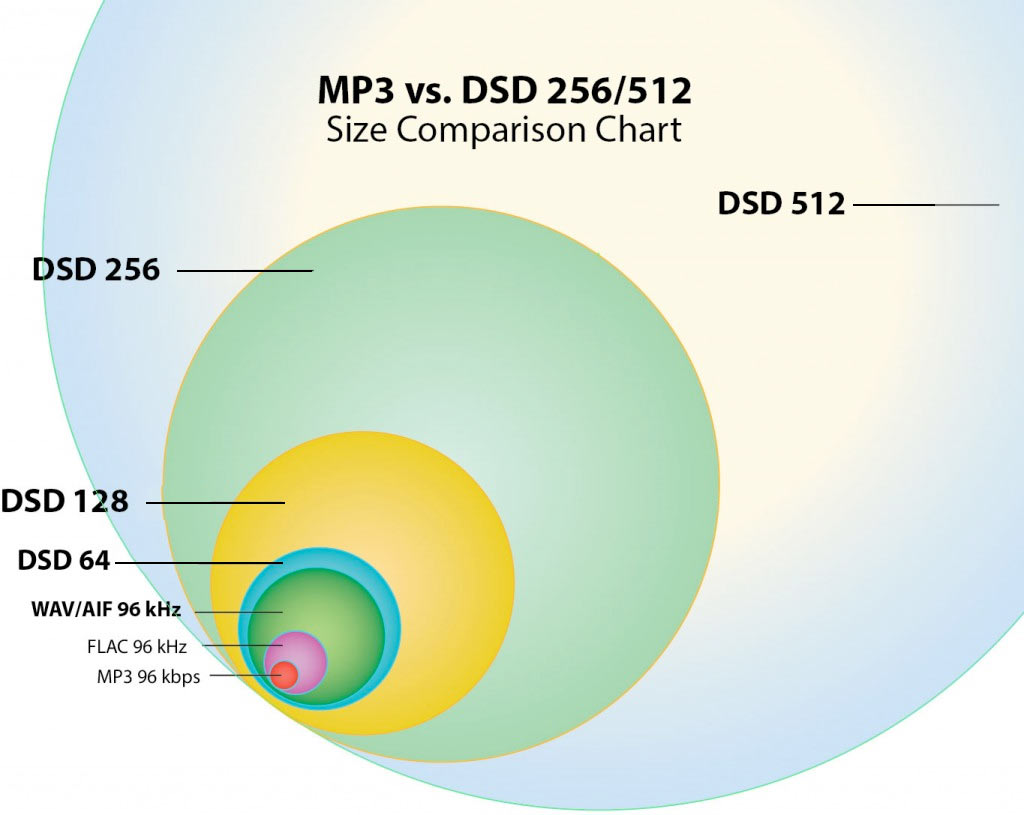From MP3 to DSD 256/512..Really?
Sometimes you just have to wonder who dreams this stuff up. I received an email from a reader the other day about a “clever” technique to remove “the digital harshness” from MP3 files. We’ve already looked at a couple of algorithms from Harman and Sony…Clari-Fi and DSEE respectively…that attempt to restore the high frequency information that is thrown away by all of the “lossy” data compression techniques. The article over at monoandstereo.com advocates converting all of your MP3 files to DSD. And not just any old DSD flavor will do…they want you to use DSD 256 or DSD 512. I wasn’t aware that DSD 512 had reached the consumer level yet. Engineers like Michael Bishop are using DSD 256 to make new masters but moving to 22.5792 MHz and 1-bit to rescue 96 kbps MP3 files seems like overkill to me. But that’s what the article wants you to do.
Let’s assume that this technique actually “make (our music) more analogue sounding”. One of the primary reasons for encoding music using lossy techniques was to make the files small enough to fit on our iPods or other portable music players. Take a look at the illustration below for a size comparison between an MP3 file and the same file in DSD 256 and DSD 512 (I couldn’t even fit the DSD 512 circle on the page!).

Figure 1 – This is a chart that I’ve displayed before developed by Blue Coast Records showing different file sizes. I’ve expanded it to include DSD 256/512. [Click to Enlarge]
Is there anyone that believes that converting MP3 files to DSD 256/512 would be worth the file size tradeoff? Wouldn’t a better solution be to reacquire the files at a higher fidelity level rather than trying to resurrect sound that has been thrown away using a conversion technique that increases the file size by almost 250 times? Playing the original CD or an MP3 at 320 kbps would do a better job.
The people behind this effort are making small, inexpensive DSD converters…the nano iDSD and the soon to be released micro iDSD. Since there’s really not that much downloadable content available in the DSD format, it’s pretty obvious that pitching a technique that converts your existing MP3 library to DSD makes a lot of sense. Or perhaps not when you think about the size of the files that you’re going to be hauling around.
There may be reasons why you or others prefer the sound of DSD to PCM or MP3s. I read a lengthy post over at AVS Forum (I got an email alerting me to a thread I was following) from a reasonable individual that was all about the “superiority of DSD over PCM”. He’s certainly entitled to his opinion but I think he would acknowledge that using mega high bit rate DSD to “clean” up MP3 files might not be the best solution.
It might be better for audio enthusiasts to leave people that are still listening to “Reduced Resolution” MP3 files alone and focus on real music fans. Why bother trying to fix a music selection and just start with a good one in the first place?


Kind of like putting a heavy diffusion filter on your camera lens and then trying to restore the sharpness with Photoshop.
Mark, your clarifying the DSD fungoo is greatly needed and appreciated. I explained to someone the other day that our industry feels (stupidly) that we must have something new and titillating to throw at the high-end market simply because manufacturers and writers cannot sustain by waving the same flag over and over. The completely un-needed appearance of balanced connections in consumer gear is one good example of this type of titillation, and DSD is the new one. Folks just love something that makes them different from the next guy. But the fact that the majority of DSD stuff ends up in the LPCM world does put a bit of an “Emperor’s clothes” spin on things. I definitely do not want to perceived as argumentative, and overall your output is a light in the darkness. Thank You.
The chart looks based on radiuses rather than areas.
In other words, the radius should increase in proportion of the square root of the file size. Instead, judging by the eye, the radius seems to increase proportionally with file size, which, if it is the case, is not correct because it exagerates the increase in file size by the power of two.
It is…you’re right. That’s why I stated that I based it on the Blue Coast Records graphics from some months ago. The point is that it is completely illogical to convert a very small MP3 to a very large DSD 256 or 512 file to get virtually nothing.
Thanks. I fully agree that upsampling a mp3 file to high PCM rates or DSD makes no sense, except for sellers of storage devices.
Let me get this straight: we convert a 98kbs file to an enormously large file to make it more analog? Aren’t we just adding another level of distortion to the chain? Whew!
Yeah, unbelievable.
Hi. I was skeptical but I have the US$189 iDSD nano and a load of crappy MP3 on music that is only available on this format. I know this is crumby to start with but assuming you have a DSD dac already, then as plug-ins are free why not? Have we really stopped trying to improve on the software side because it is already advanced enough? Try and if you dont like it, dont use it. But for me, it just makes my MP3s that bit more palletable. I did email the company about why MP3>DSD does do something nicer. Their explanation was that “the conventional digital filters interact with the processing artifacts in MP3 files and emphasise them, while the minimal filtering of DSD on replay may do more to not emphasise them or even to reduce them, at least in audibility…” Which goes completely over my head but it certainly sound that bit less “hard” to my ears.
I got my pdf from here:
http://www.akkelisaudio.com/shop/1785/art50/23422950-507b9e-Foobar2k_MP3_to_DSD512.pdf
Since Foobar 2000 and the DSD plug-in components are free, it is an easy and simple thing anyone to try for those who own a suitable DAC.
For full disclosure, I do own some of the iFi products including the 189 USD iDSD nano and I enjoyed doing this very much. The sonic results indeed gave to me a more musical, more relaxed sound that helped him to enjoy his MP3’s more. And it does run well on a fairly pedestrian laptop as well.
Does it make a 192K VBR MP3 equal to a real DSD track? Nope, of course not.
http://www.akkelisaudio.com
just wanted to say, I am keeping an open mind and this didnt disappoint and considering it cost peanuts…
I just can’t behind starting with an MP3 file. I would go back and find the music that I want at CD resolution and start with that.
Agree but i enjoy music from downloads and for some mp3 is the only option – don’t get me started on downloads…
I read the article mentioned. They are not, as you mention, advocating converting MP3s to DSD, but upscaling to DSD. How does upscaling cause the original MP3 to take up more space?
The two points you have completely missed are:
1. this is not just upconversion, but a DAC-like sigma-delta pre-rendering of the mp3/PCM data in the digital domain where it is not susceptible to clock jitter distortion. This is what most DAC chips do more or less internally (although not exactly in DSD format), but they do it on limited resources vs PC.
2. on Burr-Brown the DSD is rendered by different circuitry than PCM, resulting in a completely different sound of the MP3 being played.
Not a single person seems to understand that various formats are simply “containers” and each container develops a different sound, according to your playback chain. Converting a 320kbps mp3 into a dsd512 file is not done to increase fidelity, but to obtain that dsd512 sound even if what’s inside the container (dsd512), actually is an mp3 encoded pcm stream. It doesn’t matter what’s inside the container, dsd512 is still going to sound like it usually does, dsd 64 will do the same, flac 24-192kHz too, etc…